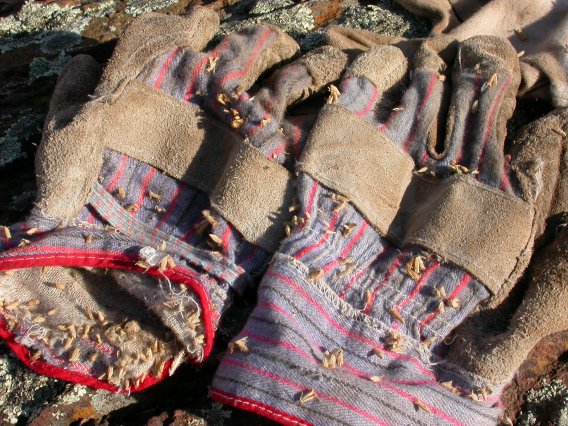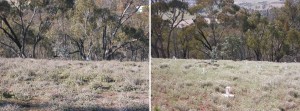Weeds on Mount Majura originate from many sources. Some escaped our gardens and some are spread by the dumping of garden waste or by recreational users.Weeds growing at the old stock-camp area at the popular ridge of Mount Majura (map) were introduced many years ago by grazing sheep. Their nutrient-rich droppings encouraged the weeds to flourish. The cessation of grazing did not stop the weeds from growing. Volunteers of the Friends of Mount Majura ParkCare group (FoMM) are assisting native vegetation to return.
Weeds primarily targeted for removal are horehound, Paterson’s Curse, thistles, and Hedge Mustard. The weeds are pulled, placed in bags, and removed from the site. Weeded sites are re-seeded with locally collected native plants (plant species list). This helps to suppress weed re-growth, as does follow-up weeding. Some of the native plants used for re-vegetation are Sticky Everlastings, New Holland Daisies and Speargrasses.
Large scale weed removal and direct seeding was begun in October 2004 on the top and at the least weed-infested parts of the ridge to the west of the Casuarina trail.
The photographs show the same site at the sheep camp with horehound in August 2005 and new holland daisies in December 2008 (photographs by Waltraud Pix).
Learn more about the sheep camp rehabilitation project.
Step by Step: Rehabilitation of a former sheep camp on Mt Majura provides more detailed information on the project.
On May 20, 2012 we held a planting bee at the sheep camp to plant 40 Drooping she-oak seedlings. Click here for more information and pictures.
The Old Sheep Camp on Mt Majura tells the history of the sheep camp. FoMM member William Mudford wrote this report as part of his Queen Scout Award Environment Project.
The Sheep Camp Gallery features pictures of the project
.
Getting involved Contact the FoMM co-ordinator at admin@majura.org



